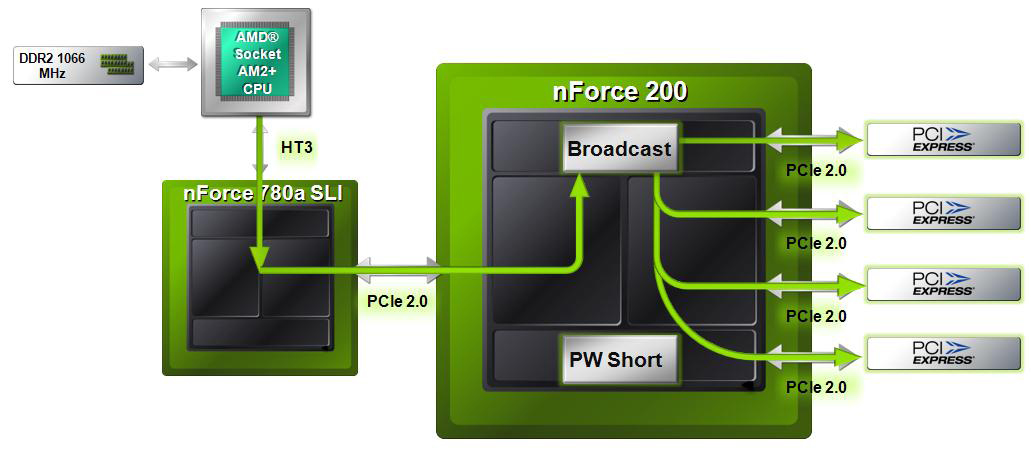ECS P55H-AK: P55/NF200 Versus X58 In 3-Way SLI
We’ve seen how three-way SLI boosts gaming performance, but do we really need X58's PCI Express connectivity to realize those gains? Using three GTX 480s, we pit the latest P55/NF200 solution from ECS against a powerful X58-based incumbent to find out.
Three-Way Goes Mainstream?
Captain Obvious dictates that, in order to properly support three graphics cards, your motherboard needs three PCIe x16 slots. Boards with three slots have been available at multiple price points for several generations. The problem with most of those boards was that the third slot was limited to only four PCIe 1.0 lanes. Nvidia would never allow such a low-bandwidth slot to support SLI because the card in the slowest slot often dragged down the performance of every other card in the array.
This is where enthusiasts might scream for a chipset with 48 PCI Express 2.0 lanes to support three graphics cards at full bandwidth from the primary controller. Unfortunately, no such product exists (though AMD comes close). Our own tests have shown that x8 mode is not much of a hindrance to SLI performance on Nvidia’s fastest cards, since CPU bottlenecks come into play long before a PCIe 2.0 x8 slot is completely tapped-out.
So, is the real requirement of three-way SLI really something as simple as a chipset that has 24 direct pathways? While many of our readers recommend X58-based motherboards to their friends specifically for the platform's 36 PCIe 2.0 pathways, we didn’t say that those lanes all had to come from a PCI Express controller. Long ago, Nvidia figured out that, since every card in an SLI array uses the same data, repeating data is an easy way to feed two graphics cards with the full 16 lanes of bandwidth from a chipset that supports only one x16 card. Nvidia calls this method “broadcast” and began using it several years ago to convert its low-cost 750a SLI chipset into a multi-card-supporting monster.
This bridge has since been used on everything from its 680i to Intel’s X58, opening three-way SLI to a broad customer base. Today we consider one such motherboard that allows buyers of mainstream LGA 1156 processor buyers to seek the ultimate level of features and graphics performance, and see how it compares to an LGA 1366 alternative.
Get Tom's Hardware's best news and in-depth reviews, straight to your inbox.
-
TheRockMonsi Well, if I'm shocked at anything, it's that the P55 platform actually outdid the x58 on some benchmarks. From a pure video card usage's perspective, you really won't be missing out on anything going for the P55 over the x58.Reply
And while this makes the P55 look good, what really sucks - if you're looking into the longevity of the P55 motherboards anyway - is that the new "Sandy Bridge" CPU's coming out in 2011 will feature a 1155 socket instead of an 1156, which means upgrading to a new motherboard. -
rmmil978 Very interesting reading, a bit shocked at the outcome. P55 can really be a viable alternative to X58 after all, even for the enthusiast crowd.Reply -
adbat Yes the 1156 platform is going bye bye it's realy sad.Reply
But i think that it shows that moving PCIa to CPU die is not a good idea as P55 with additional chip wins in the end - even the power usage test. -
Crashman adbatYes the 1156 platform is going bye bye it's realy sad.But i think that it shows that moving PCIa to CPU die is not a good idea as P55 with additional chip wins in the end - even the power usage test.Remember that in this case, the additional chip is acting as a signal repeater. That is to say, you really don't need more than sixteen lanes from the CPU, for optimal SLI performance you only need those same 16 lanes to feed all graphics cards simultaneously.Reply
-
tacoslave TheRockMonsiWell, if I'm shocked at anything, it's that the P55 platform actually outdid the x58 on some benchmarks. From a pure video card usage's perspective, you really won't be missing out on anything going for the P55 over the x58.And while this makes the P55 look good, what really sucks - if you're looking into the longevity of the P55 motherboards anyway - is that the new "Sandy Bridge" CPU's coming out in 2011 will feature a 1155 socket instead of an 1156, which means upgrading to a new motherboard.yeah i hate how they took of one pin just to f@#$ with us.Reply
-
compton What an awesome board ECS has put together. I'd like to see a full review of this board - I'm intrigued with the effort ECS has put it to make what seems like a excellent piece of gear. Perhaps this will result in the trickle down effect if ECS is successful, that is, maybe starting at the high end will result in better mid- and low- range boards.Reply -
Nvidia does not seem to be bothered by continuing production of 65nm NF200. Would like to know if there is any R&D into a die-shrink to 40nm or less.Reply
-
martel80 tacoslaveyeah i hate how they took of one pin just to f@#$ with us.IIRC they didn't just take out one pin but they also redesigned how clocking of the CPU works. 1155 CPUs will have their own clock generator (as opposed to 1156's board-generated clock) and the board needs to support this. They could possibly hack-around this but why would they bother? Sheep will always buy the latest Intel stuff no matter what. :)Reply -
dogman_1234 Now let all the trolls come out about the LGA 1155 release!Reply
Seriously, as a respective consumer to Intel, i have began to dislike their practices. Why do I not want SB? Hmmm...good question, same reason I do not want P55..short live and full of disaster!

